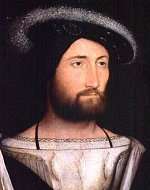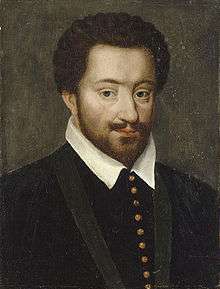Palace of the Dukes of Burgundy
Coordinates: 47°19′18″N 5°2′30″E / 47.32167°N 5.04167°E
| Palace of the Dukes and Estates of Burgundy | |
|---|---|
| Palais des ducs et États de Bourgogne | |
|
the Palais des ducs de Bourgogne | |
| General information | |
| Type | Ducal Residence, Royal residence |
| Architectural style | Gothic architecture, French Baroque architecture |
| Location | Dijon |
| Construction started | 1364 (for the Medieval palace) |
| Completed | 1737 (completed by the grand escalier) |
| Client | Philip the Bold, Duke of Burgundy |
The Palace of the Dukes and Estates of Burgundy or Palais des ducs et des États de Bourgogne is a remarkably well-preserved architectural assemblage in Dijon. The oldest part is the 14th and 15th century Gothic ducal palace and seat of the Dukes of Burgundy, made up of a logis still visible on place de la Liberation, the ducal kitchens on cour de Bar, the tour de Philippe le Bon, a "guette" overlooking the whole city, and tour de Bar. Most of what can be seen today, however, was built in the 17th and especially the 18th centuries, in a classical style, when the palace was a royal residence building and housed the estates of Burgundy. Finally, the 19th façade of the musée on place de la Sainte-Chapelle was added on the site of the palace's Sainte-Chapelle, demolished in 1802. The Palace houses the city's town hall and the musée des Beaux-Arts.
History of the Palace of the Dukes

The Duchy of Burgundy was founded in the 9th century around the year 880 from the Kingdom of Burgundy, by the Carolingian kings Louis III and Carloman II of France, and the princes who shared the Carolingian Empire after reorganizing the entire kingdom into duchies and counties. Richard II of Burgundy, known as Richard the Avenger, was named marquis and first Duke of Burgundy. He was one of the six Peerage of France installed under his suzerain, King Louis III of France.
The Dukes of Burgundy ruler of the Duchy of Burgundy (1363–1477)
- Philip the Bold (1342–1404), son of the King John II of France
- John the Fearless (1371–1419)
- Philip the Good (1396–1467)
- Charles the Bold (1433–1477)
 Philip the Bold (1342–1404)
Philip the Bold (1342–1404) John the Fearless (1371–1419)
John the Fearless (1371–1419) Philip the Good (1396–1467)
Philip the Good (1396–1467) Charles the Bold (1433–1477)
Charles the Bold (1433–1477)
Palace of the Estates of Burgundy
The palace turned into a Royal residence when the Duchy of Burgundy was occupied by the Kingdom of France after the death of Charles the Bold, in 1477, and the treaty of Arras of 1482 between the king Louis XI and Maximilian I, Holy Roman Emperor.
Governors of Burgundy
After 1477, the kings of France named governors to rule Burgundy. Sometimes they came personally to Dijon, where the palace was turned into a royal residence to receive them while in the province of Burgundy.
 Louis de la Trémoïlle (1460–1525)
Louis de la Trémoïlle (1460–1525) Philippe de Chabot (1492–1543)
Philippe de Chabot (1492–1543) Antoine de Lorraine (1489–1544)
Antoine de Lorraine (1489–1544) Claude de Lorraine (1496–1550)
Claude de Lorraine (1496–1550) Charles, duc de Mayenne (1554–1611)
Charles, duc de Mayenne (1554–1611) Charles de Gontaut, duc de Biron (1562–1602)
Charles de Gontaut, duc de Biron (1562–1602) Roger de Saint-Lary de Termes, duc de Bellegarde (1562–1646)
Roger de Saint-Lary de Termes, duc de Bellegarde (1562–1646)- Le Grand Condé (1621–1686)
 Louis de Bourbon Condé (1692–1740)
Louis de Bourbon Condé (1692–1740) Louis Joseph de Bourbon Condé (1736–1818)
Louis Joseph de Bourbon Condé (1736–1818)
The palace today
The ducal tombs were reinstalled in the Salle de garde following the razing of the Chartreuse de Champmol. During the 2010–12 renovation of the palace, a number of sculptures from tombs have traveled on exhibit.[1]
See also
References
External links
-
 Media related to Palais des Ducs (Dijon) at Wikimedia Commons
Media related to Palais des Ducs (Dijon) at Wikimedia Commons - Official Site of the Musée des Beaux-Arts de Dijon
